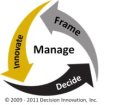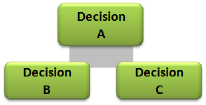Increase your effectiveness with a sound decision making process
 Frame, Innovate, Decide, then Manage, forms the basis for our decision making process. Our process is built on a decision making model that captures information in the form of one or more decisions. Decisions become knowledge "containers" that help us move an overwhelming flood of information into an accessible knowledge structure that helps rather than hinders.
Frame, Innovate, Decide, then Manage, forms the basis for our decision making process. Our process is built on a decision making model that captures information in the form of one or more decisions. Decisions become knowledge "containers" that help us move an overwhelming flood of information into an accessible knowledge structure that helps rather than hinders.
Frame your decision or network of decisions
 What is your decision environment? What needs must be addressed? Who is impacted? What information is available (watch out for information overload)? What is the value of the decision? When is the decision needed?
What is your decision environment? What needs must be addressed? Who is impacted? What information is available (watch out for information overload)? What is the value of the decision? When is the decision needed?
To increase your decision making accuracy you want to expend effort on framing the context of your decision. Don't forget about establishing the value of the decision! You don't want to spend 10 minutes on deciding what coffee to buy. It's not worth your time. On the other end of the spectrum, it is also a mistake to only spend $200 on a $200,000 decision. (See more on planning decision making.)
Innovate to better address needs
 How many alternatives have you considered during the decision process (if only 2 you are not done)? Do you need a new solution, or are previous solutions adequate? Reuse is a key part of the innovate stage. Innovation does not mean re-invention. Decision making advantages can be created through innovation, but create new alternatives that bring new benefits, not just new work. Remember that deciding fast can be a benefit. Recognize that innovation can be enhanced through collaboration which would require additional time but leads to better results. (See more on decision alternatives.)
How many alternatives have you considered during the decision process (if only 2 you are not done)? Do you need a new solution, or are previous solutions adequate? Reuse is a key part of the innovate stage. Innovation does not mean re-invention. Decision making advantages can be created through innovation, but create new alternatives that bring new benefits, not just new work. Remember that deciding fast can be a benefit. Recognize that innovation can be enhanced through collaboration which would require additional time but leads to better results. (See more on decision alternatives.)
Decide and commit to act
Evaluate your alternatives based on your criteria. Does one stand out as a clear winner? Which alternatives, while highly attractive, are also laden with excessive risk? Which alternatives more closely align with strong opportunities? Have you spent the effort needed to ensure a quality decision making result? If so, decide, then determine what is needed next and commit to required actions. (Learn more on how to make a decision with our decision analysis process.)
Manage communication, consequences, changes, risks, ...
Is it over, yet? Maybe, with low value isolated decisions. However, with most decisions you can expect to have to communicate to those impacted, and manage any number of consequences, including impacts to relationships. Don't be surprised to see a medium to high value decision generate a large network of related decisions. (See the Manage step for more on decision implementation.)
Learn more about the process for decision making from the following topics
The Frame step - Planning decision making
The Frame step starts the decision making process and envisions success for the decision.
The Innovate step - Generating decision alternatives
The Innovate Step identifies decision alternatives that lead to an effective solution.
The Decide step - How to make a decision
The Decide step addresses how to make a decision by taking a closer look at the decision analysis process.
The Manage step - Ensuring decision implementation
Reaching the desired outcome during decision implementation is addressed in the Manage step of our decision making process.
Decision analysis tools
See our analysis tools and worksheets for completing decision evaluation.
Decision Making Model
Build on the knowledge of others as well as your own when you use this unique decision making model.
Group Decision Making Process
Increase team effectiveness by managing the group decision making process.
Decision making capability assessment
Are your organization's decisions creating value? Use our skills assessment to identify improvement opportunities.
Problem Solving Decision Making
Problem solving decision making is part of an integrated process.
Making Good Decisions
Assess decision quality to help in making good decisions.
Learning from Mistakes
Benefit from decision making lessons that come from decisions that fail.

